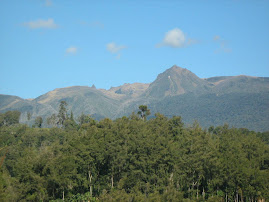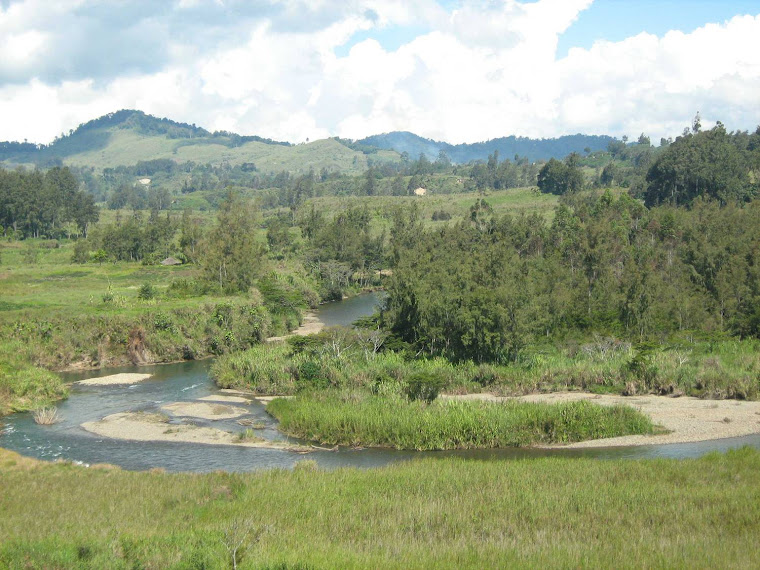 I missed seeing the sacred Olympic Flame
I missed seeing the sacred Olympic FlameBy Mathew Yakai in Changchun, China
THEY came in their millions, from all works of life, old and young, men and women from the outskirts and within Changchun city.
Among the millions were also foreigners from different countries, working, studying, and doing business in Changchun, situated at the heart of Songliao Plains in northeast China.
Out of these millions was a lone Papua New Guinean, which was me.
THEY came in their millions, from all works of life, old and young, men and women from the outskirts and within Changchun city.
Among the millions were also foreigners from different countries, working, studying, and doing business in Changchun, situated at the heart of Songliao Plains in northeast China.
Out of these millions was a lone Papua New Guinean, which was me.
It was Monday, the 14th of July 2008. Zeng Li, my good Chinese friend and a colleague at Jilin University arranged two bicycles and two Olympic Torch t-shirts for us.
I met him at the school stadium at 9am on that day to watch the 2008 Beijing Olympic Torch relay which was held in the city.
The day I would hardly miss. I packed my camera, hoping to get the best picture of my life time. The picture I had in mind that will be the best of my experience, a remarkable souvenir and would possibility make a book chapter in the future.
On the way, as usual, the traffic was jammed. And given that the Torch was in town, you would hardly have a space to shove through.
Zeng bought four flags, two flags of the People’s Republic of China and two Olympic flags. I put mine on my bike, and it was absolutely outstanding, and got a lot of attention.
We were not sure of the whereabout of the Flame so Zeng asked a policeman manning the traffic. He directed us to Jingyuetan National Forest Park in the city.
The entire street was packed with people, marching towards the same park, some 15 min by bicycle.
The temperature was at 34 degree Celsius and the people could stand the summer heat. But for me and Zeng, we made it possible on the bike, and it was fun also.
When we arrived at the Park, the entire street was sealed off and the police at the scene stopped us. Zeng turned back and insisted that I follow him.
I realized that he wanted us to make it through the back gate but when we arrived, the police were already there stopping us.
A kind policeman asked us to make it to Changchun Sculpture Park and secure a spot because that would be the last leg for the Torch in the city.
Zeng explained to me that we had to get to the Sculpture Park as soon as possible or we will not have any chances of seeing the Torch. It took us about 20 odd minutes riding through the dangerous and crowded traffic under the summer heat.
Eventually, we arrived at the vicinity, but again, the spot was fenced off by police and insisted that we would not pass through.
I tried several spot around the Park to have the glimpse of the torch but the entire possible spots were overwhelmed with people. We were literally late.
I told Zeng that I missed an important moment in my life. But he said that at least we felt the presence of the Torch and in the Olympic mood.
Actually, we were late because the first torchbearer Wang Jiaqi, academician of the Chinese Academy of Sciences started at 8:08 a.m. There were 218 torchbearers carrying the Olympic flame along the nine-km-long journey within the city.
Last torchbearer Wang Chunlu, a Winter Games short-track silver medalist, lit the cauldron at Changchun World Sculpture Park at 10: 04 a.m. to end the Changchun leg of the Olympic Torch Relay.
We left the university at 9am and by the time we arrived at several sport, the space were already taken up by Torch enthusiasts.
The Torch left Qiqihar city in Heilongjian province on July 13 for Changchun city, the capital of Jilin province on July 14. The Torch was in the province for three days and will leave for Qingdao city in Shandong province tomorrow.
So far, the Torch has covered 85 cities in China and has another 15 cities to go before it arrives in Beijing on August 6 for the grand opening of the 2008 Olympic Games on August 8.
On March 24, the torch lighting ceremony was successfully completed in Athens, signaling the start of the torch relay in Greece.
On Sunday, March 30, the Greek leg of the torch relay officially concluded, with the handover of the torch to BOCOG at Panathenaikon Stadium in Athens.
The sacred flame headed to Beijing with a big welcoming ceremony launching the start of the 2008 Games.
The flame then begins its worldwide tour starting at Almaty's Astana Square on Wednesday April 2. This is the first time that an Olympic Torch has passed through this Kazakhstani city.
The Torch then passed through 18 cities around the world in all the continents and arrived in Hong Kong Friday May 2, starting its local leg.
When the Torch reach Beijing on August 6, it will “light the fashion” on August 8 and that will be the beginning of three weeks long glamour of sportsmanship when athletes from all over the world upholding the spirit of Olympia.
The modern Torch Relay is a non-competitive replication of the ancient Flame relay and a symbolic celebration of the Olympic Games.
In a prophetic speech at the end of the Stockholm Games, on June 27, 1912, Baron Pierre de Coubertin said: "And now, great people have received the Torch, and have thereby undertaken to preserve and quicken its precious Flame. Lest our youth temporarily let the Olympic Torch fall from their hand, other young people on the other side of the world are prepared to pick it up again."
The Torch Relay, as the opening of the Olympic celebration, was revived in the Berlin Olympiad in 1936 and since then the Torch Relay has preceded every Olympic Summer Games.
Starting from Olympia and carried by the first runner, the young athlete Konstantinos Kondylis, the Flame travelled for the first time hand to hand until it reached the Berlin Olympic Stadium. Since, the Flame's magic has marked and has been identified with the beginning of the Games.
In Olympiads that followed, the Torch Relay continued to play an important role, having been enriched with the characteristics and cultures of the host countries.
The choice of the athlete who lights the Flame in the Olympic stadium is always symbolic to the host country.
For the 1960 Olympic Games in Rome, the Flame followed a route in homage to the Greek and Roman civilizations.
It was carried from Piraeus to Rome on the ship 'Americo Vespucci' and passed through some of the best-known or important historical monuments of the two countries. It was the first time that the event was covered by television.
In the Mexico Olympiad in 1968, the Flame followed the route taken by Christopher Columbus, and the athletics champion Enriqueta Basilio was the first woman to light the Flame in the Olympic stadium.
For the Montreal Games in 1976, the Flame travelled by satellite from Athens to Ottawa, and in the 1992 Games in Barcelona a Paralympic Archery medalist Antonio Rebollo lit the Flame in the stadium with a burning arrow.
In Sydney 2000, the Flame made its journey underwater in the Great Barrier Reef and covered the longest distance in the history of the Games so far.
The Athens 2004 Olympic Torch Relay was the first global journey of the Flame.
And in this Beijing 2008 Game, China has stunned the world by taking the Flame up to the highest peak on Earth, Mt Everest which forms part of its longest Olympic Torch leg.
Fire is a sacred symbol dating back to prehistoric times. In ancient Greece it symbolized the creation of the world, renewal and light.
It was also the sacred symbol of Hephaestus, and a gift to the human race from Prometheus, who stole it from Zeus.
At the centre of every city-state in ancient Greece there was an altar with an ever-burning fire and in every home the sacred Flame burned, dedicated to Hestia, goddess of the family.
Torch Relay races started in ancient Greece as religious rituals held at night. Soon they turned into a team athletic event, initially among adolescents, and further developed to become one of the most popular ancient sports.
The enchanting power of fire was a source of inspiration. Sacred flames lit by the rays of the sun always burned in Olympia, in an altar dedicated to Hestia.
Fire was ignited with the help of a concave mirror, which has the ability to concentrate the rays of the sun on a single spot. When the head priestess touched that point with the Torch, the Flame was lit.
The Ancient Greeks held a "lampadedromia" (the Greek word for Torch Relay), where athletes competed by passing on the Flame in a relay race to the finish line.
In ancient Athens the ritual was performed during the Panathenaia fest, held every four years in honor of the goddess Athena.
The strength and purity of the sacred Flame was preserved through its transportation by the quickest means; in this case a relay of Torchbearers.
The Torch Relay carried the Flame from the altar of Prometheus to the altar of goddess Athena on the Acropolis. Forty youths from the ten Athenian tribes had to run a distance of 2.5 km in total.
For the modern Olympic Games the sacred Flame is lit in Olympia by the head priestess, in the same way as in antiquity, and the ritual includes the athletes' oath.
The Flame is then transmitted to the Torch of the first runner, and the journey of the Torch Relay begins, its magic still touching people today.
On Monday 14th, that sacred flame brightened up the 7.4 million people of Changchun city.
By August 6 when it arrives in Beijing, it will brighten up the entire China. In August 8 during the grand opening of the Game, the whole world will feel the spirit of this sacred Flame.
In this century when terrorism, climate change, fuel price increase, HIV/Aids epidemic and other common problem dominates the perspective of humanity, the Olympic sacred Flame has arrived at the time to brighten our perspective….”to learn to live together and solve common problems together”.
Note: “Asia-Pacific Perspective: China +” looks at Chinese society, culture, economy, governance and China’s role within the Asia-Pacific region and the world over. It mainly focuses on how PNG can learn from China’s experience. The writer is a PNG student in China









No comments:
Post a Comment